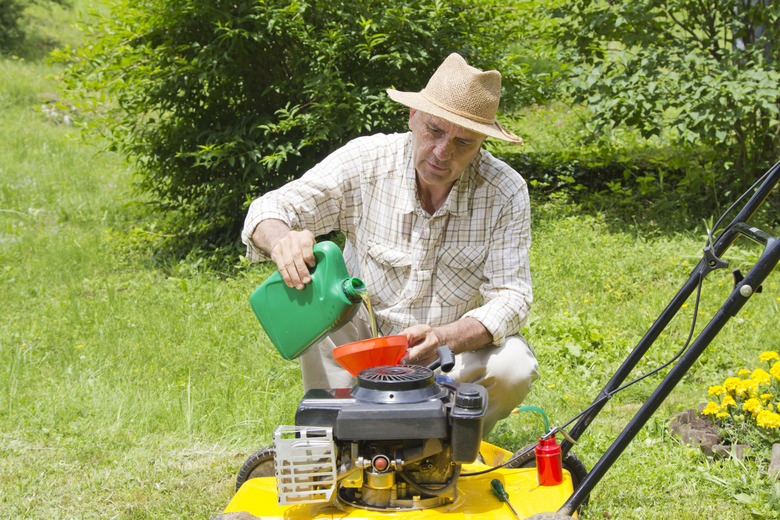How Does A Lawn Mower Engine Work?
Englishman Edwin Budding invented the manual lawn mower in 1830, but motorized versions of his reel-type mower never became as popular as the rotary mower invented by William Beazley in 1929. If you have a power mower in your garage, it's probably a rotary mower, and it may have a two- or four-stroke engine.
Englishman Edwin Budding invented the manual lawn mower in 1830, but motorized versions of his reel-type mower never became as popular as the rotary mower invented by William Beazley in 1929. If you have a power mower in your garage, it's probably a rotary mower, and it may have a two- or four-stroke engine. To keep your mower running well and your lawn in tip-top shape, it's helpful to understand how your mower operates.
Small Engine Operation
The power to spin the cutting blade on a rotary mower comes from the movement of a piston, which is in turn powered by the controlled explosion of fuel inside a combustion chamber. The combustion chamber has an intake and an exhaust port; fuel and air come through the intake port during the piston's downward stroke, and the mixture ignites at the top of the upward stroke. In a four-stroke engine, the piston completes two upward-and-downward cycles for every spin of the crankshaft, which spins the blade. In a two-stroke engine, each up-and-down cycle of the piston produces a rotation of the shaft.
- Englishman Edwin Budding invented the manual lawn mower in 1830, but motorized versions of his reel-type mower never became as popular as the rotary mower invented by William Beazley in 1929.
- The power to spin the cutting blade on a rotary mower comes from the movement of a piston, which is in turn powered by the controlled explosion of fuel inside a combustion chamber.
The Function of the Carburetor
Whether it's a two- or four-stroke engine, the carburetor provides the proper mixture of fuel and air to the combustion chamber. If the mixture is too lean — which means there is too much air — the fuel burns hot and the engine lacks power. If the mixture is too rich, the fuel may not ignite, and if it does, it may burn inefficiently and produce smoke, and the engine may perform poorly. Carburetors have adjustment screws so you can fine-tune the fuel mixture. Although these are preset on your new mower, they often need adjustment after you've used the mower for a year or so.
Lawnmower Lubrication
All internal combustion engines need lubrication oil, or the metal parts overheat through frictional contact, and they seize. If your lawnmower has a two-stroke engine, you add the oil directly to the fuel; it burns up in the combustion chamber. If your lawnmower has a four-stroke engine, you add oil separately; it's stored in a crankcase from where it is circulated throughout the engine by a pump. If your lawnmower doesn't have an oil port, it's essential to mix oil with the fuel in the ratio recommended by the manufacturer. Modern mowers take 1 part of oil to 50 parts fuel, but older mowers can take more oil, as much as 1 part per 32 parts fuel.
- Whether it's a two- or four-stroke engine, the carburetor provides the proper mixture of fuel and air to the combustion chamber.
- If your lawnmower doesn't have an oil port, it's essential to mix oil with the fuel in the ratio recommended by the manufacturer.
Ignition System
The flywheel is an essential part of the engine; it's connected to the crankshaft and spins when the piston cycles. You start the lawnmower by spinning the flywheel, either with a manual starter or an electric one. When the flywheel begins spinning, it generates an cyclical electric current that fires the spark plug, which in turn ignites the fuel in the combustion chamber. Once you supply the initial energy to start the cycle, it continues on its own until you stop it. A spark plug that misfires because it's worn or dirty will prevent the engine from operating — replace the plug regularly.
